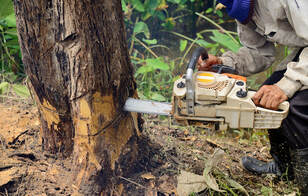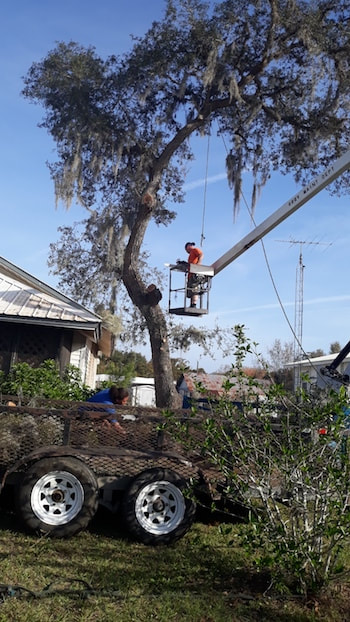Tree removal greatly depends on the tree in question. It will be impossible for a certified arborist to determine the cost of tree removal without seeing the tree with his own eyes. The arborist needs to pay a visit to your property and inspect the tree before he gives you an accurate estimate.
Factors to consider in determining tree removal cost
If the Cost is Too Low, You Might Need to Think Twice and Ask these Questions:
For smaller trees, it is possible to remove them yourself with the right equipment and technique. Removing a tree requires the use of power tools such as a handsaw or a chainsaw. The process of removing a tree should begin with careful planning and follow by proper execution. It will help a lot if you ask someone with experience operating a chainsaw if it's your first time doing it. Make sure to obtain the requirements before getting started.
Prepare to Cut Down the Tree Prepare the area to prevent accidents when the tree falls. Look at where the tree is falling and its surrounding area. Make sure it's far from your house or any fixed structure, including power lines. Get someone experienced in removing a tree to help you in the process. Consider trees as well. Removing a tree may affect other trees, especially ones that are weaker and smaller. Decide What Direction to Fell a Tree It is crucial to find out where the tree is falling to ensure you and your property's safety. If the tree is leaning towards one direction, it is best to fell it in that way. Just make sure there are no structures that will be affected. Getting Away Don't begin sawing until you have removed undergrowth around the tree. Get rid of fallen limbs, branches, and other obstruction in the way. Clearing Tree Limbs and Buttress Roots from a Tree Clear the lower part of the tree of any small branches and buttresses using the chainsaw. You can use a pulling chain to remove branches. At a downward angle, begin cutting from the top. Don't cut limbs that go higher than your shoulders because it is perilous. Directional Felling: How to Fell a Tree in the Right Direction The direction of the tree's fall largely depends on the first few cuts you make or what is called the directional notch. You can make a directional notch in different ways, including the open directional notch. Use these practical steps to make an open directional notch using a chainsaw:
In cutting a large tree, it is vital to use the right cutting technique. If you have a large tree that has a diameter larger than the chainsaw bar, a plunge cut is necessary. A felling wedge and a breaker are some of the tools you will need to safely and successfully cut down a tree.
When it comes to felling a dead or rotten tree, you may need help from expert tree service. It is extra challenging to remove trees of this kind, and you need to practice extra caution. If you see that the trunk is hollow or discolored, it can be an indication of rot in its interior. It is crucial to use a larger hinge to effectively and safely remove rotten and dead trees. Lodged Tree Don't leave the tree that is stuck in another tree without addressing the matter. You should call a professional tree service company right away if the tree lodges in a tree on its way down. You should make the pedestrians aware of the danger by roping the area, then call for help. Learn more.  If you have ever cut a tree down in your life, you know that it is not a simple job. The truth is, cutting a tree is a dangerous task, and it can cause severe injuries if not done correctly. If you are planning to cut a tree on your own, you should make a careful consideration of the things you need to do before getting the chainsaw and cutting the tree. You don't want to end up on a hospital bed because of negligence and the wrong thought that it is a job that an average guy can do. In this blog, we will discuss important things that you need for cutting a tree. We hope that this can help you cut that tree down correctly and safely. Materials You Need When cutting down a tree, you will need:
Check the Tree to See if it is Out of Your Capacity Before you begin cutting the tree, the first thing you should do is assess the tree and the entire situation and see if it is something within your limits. It is best to know what you are capable and not capable of doing before you start cutting that tree only to leave it unfinished. Remember that not all trees are the same. They should be handled differently, and they need a proper approach to be able to cut them down correctly. One good example is a tree close to a power line, fences, or building. If you see that this is the case for you, it is much better to call a professional tree company to handle tree cutting for you. If you try to do it yourself and it falls in the wrong direction, you will be held financially liable for damaged properties. Also, the lack of proper equipment can make it difficult for you to cut down a tree. If a tree is leaning heavily on one side, chances are it will fall on that side. Having a crane will make the work more comfortable for you, but you may not have it at your disposal that is why in this situation, leave it to the professional. Further, you may also want to check if it is safe for you to climb up the tree. Inspect the tree for dead or broken branches. One wrong step on these branches can cause you injury, so you have to be extra careful. Estimate the Falling Distance Once you are done assessing the tree and you have your safety gears on, the next step is to estimate where the tree will fall. This is a crucial part of the process of cutting down a tree. If a tree falls on you, you will inevitably end up in the hospital, and that's the least we want to happen. Some trees reach a height of more than 200 ft. That is why it can be challenging to tell where it can be falling. To accurately estimate where the tree will fall, you should measure the height of the tree using a crane. Use a tape measure to find out the exact distance of the fall. Another technique is by holding your ax upside down and outstretch your hand. Move back with one eye closed until the ax barely "covers" the sight of the tree. This will help you determine whether the top of the tree will fall in the direction you desire. This is an essential part of making sure you and your property are safe when the tree falls, so we highly recommend you to give it time and effort. You don't want to be surprised that the tree falls exactly on your roof once the process is done. Clear a Separate Escape Route Without the aid of cables and braces, it will be difficult to say where the tree will exactly fall. There are also other natural forces that can make it challenging for you to cut it down. One example is wind. We cannot control where the wind blows, and the wind may cause the tree to fall on the opposite direction of where you originally planned it to take down. If this happens, you should be ready with a plan. Make sure you clear an escape route opposite the direction of where you wanted your tree to fall. This will allow you to have a place to run to in case the tree falls toward you. Safety should always come first; that is why you need to be ready with an alternate path for yourself when the unexpected happens. Cutting down a tree is never an easy task. Even the most professional tree service can still get themselves hurt due to unforeseen situations that is why we encourage you to practice caution when cutting down a tree. |
AuthorTampa Tree Service Archives
February 2024
Categories
All
|


 RSS Feed
RSS Feed